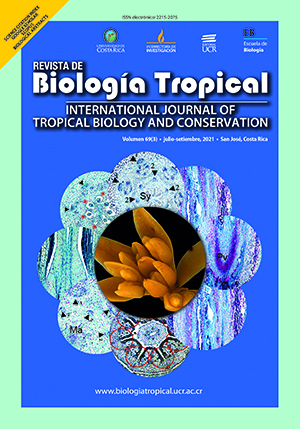Resumen
Introducción: Gaiadendron punctatum es una especie hemiparásita perteneciente a uno de los tres géneros basales de la familia Loranthaceae, siendo los otros dos Nuytsia y Atkinsonia. El género está conformado por dos especies distribuidas en regiones montañosas de Sudamérica y Centroamérica. Tanto los estudios embriológicos, como los filogenéticos, indican una tendencia hacia la reducción del gineceo y de los óvulos en la familia, cuya morfología respalda la circunscripción de la tribu Gaiadendreae (Gaiadendron y Atkinsonia). Estudios filogenéticos moleculares sugieren que Nuytsia, Atkinsonia y Gaiadendron divergieron sucesivamente, formando un grado en la base de la familia Loranthaceae, pero los valores en los que se sustenta son bajos. Objetivo: En el presente trabajo se describe la anatomía floral de la especie Gaiadendron punctatum con el objetivo de complementar la información embriológica, de manera que se pueda comparar directamente la morfología floral y los caracteres embriológicos entre los tres géneros basales de la familia Loranthaceae y reevaluar sus relaciones. Métodos: Las flores de G. punctatum fueron recolectadas en diferentes estados de desarrollo, se realizaron cortes histológicos seriados, se tiñeron con azul de astra y fucsina, y se analizaron mediante microscopía óptica. Resultados: Las inflorescencias mostraron un desarrollo acrópeto, las flores bisexuales presentaron ovario ínfero con presencia de una estructura en forma de anillo, carente de tejidos vasculares llamada calículo; el ovario se compone por siete lóculos basales, cada uno con un óvulo atégmico tenuinucelar. Por encima de los óvulos, el mamelón se fusiona con los tejidos adyacentes. El androceo está conformado por siete estambres epipétalos, las anteras presentan un endotecio fibroso y granos de polen tricolpados. La dehiscencia de las anteras es mediante una sola apertura longitudinal. Conclusiones: Los resultados del presente trabajo demuestran que Gaiadendron y Atkinsonia comparten anteras dorsifijas y versátiles, mientras Gaiadendron y Nuytsia comparten el tipo de dehiscencia anteral y por otro lado Gaiadendron comparte los caracteres de mamelón amilífero y calículo no vascularizado con la tribu Elytrantheae. La clasificación del género Gaiadendron con respecto a los dos géneros basales de la familia debe ser objeto de investigación (análisis filogenético combinado) que permita dirimir si la tribu Gaiadendrae es un clado, un grado o dos géneros más lejanamente emparentados.
Citas
Bhatnagar, S., & Johri, B.M. (1983). Embryology of Loranthaceae. In M. Calder & B. Peter (Eds.), The biology of mistletoes (pp. 129–143). University of Melbourne, Australia.
Cid-Villamil, R.M. (2006). Biología del desarrollo de Cladocolea loniceroides (Van Tieghem) Kuijt (Loranthaceae). Tesis de Doctorado, Universidad Nacional Autónoma de México, México.
Cocucci, A.E. (1982). El ovulo y el gineceo en Loranthaceae. Boletín de la Sociedad Argentina de Botánica, 21, 131–141.
Dixit, S. (1958). Morphological and Embryological Studies in the Family Loranthaceae IV. Amyema Van Tiegh. Phytomorphology, 8, 346–364.
Dueñas-Gómez, H.C. (2015). Loranthaceae. En R. Bernal, S. Gradstein, & M. Celis (Eds.), Catálogo de plantas y líquenes de Colombia (pp. 1487–1493). Editorial Universidad Nacional de Colombia.
Dueñas-Gómez, H.C., & Franco-Roselli, P. (2001). Sinopsis de las Loranthaceae de Colombia. Caldasia, 23, 81–99.
Garg, S. (1958). Embryology of Atkinsonia ligustrina (A. Cunn. ex F. Muell.) F. Muell. Nature, 182(4649), 1615–1616.
Grimsson, F., Grimm, G.W., & Zetter, R. (2017). Evolution of pollen morphology in Loranthaceae. Grana, 57, 16–116.
Johri, B.M., Ambegaokar, K.B., & Srivastava, P.S. (1992). Comparative embryology of angiosperms. Springer-Verlag.
Kuijt, J. (1981). A rejoinder on Oryctina (Loranthaceae). Plant Systematic and Evolution, 137, 215–219.
Kuijt, J. (2015). Santalales. In J. Kuijt & B. Hansen (Eds.), The families and genera of vascular plants, Flowering plants: Eudicots; Santalales, Balanophorales (pp. 1–189, Vol. 12). Springer.
Kuijt, J., & Graham, J.C. (2015). Two New Species of Loranthaceae from Central Peru. Novon A Journal for Botanical Nomenclature, 24, 173–178.
Lamilla, L.A., Robayo, C.A., Castaño, F., Marquínez, X., & Raz, L. (2020). Floral anatomy of Tristerix longebracteatus (Loranthaceae). Revista de Biología Tropical, 68, 87–98.
Narayana, R. (1958a). Morphological and Embryological Studies in the Family Loranthaceae - III Nuytsia floribunda (Labill) R.Br. Phytomorphology, 8, 306–323.
Narayana, R. (1958b). Morphological and embryological studies in the family Loranthaceae - Lysiana exocarpi (Behr) Van Tieghem. Phytomorphology, 15, 146–168.
Nickrent, D.L., Malécot, V., Vidal-Russell, R., & Der, J.P. (2010). A revised classification of santalales. Taxon, 59, 538–558.
Nickrent, D.L., Anderson, F., & Kuijt, J. (2019). Inflorescence evolution in Santalales: Integrating morphological characters and molecular phylogenetics. American Journal of Botany, 106(3), 402–414.
Prakash, S. (1960). Morphological and embryological studies in the family Loranthaceae - VI. Peraxilla tetrapetala (Linn. F.) van Tiegh. Phytomorphology, 10, 224–234.
Prakash, S. (1961). Morphological and Embryological Studies in the Family Loranthaceae - VII Atkinsonia Ligustrina (Cunningh) FV Muell. Phytomorphology, 11, 325–335.
Raj, B. (1970). Morphological and Embryological Studies in the Family Loranthaceae-XIII. Amylotheca dictyophleba Van Tiegh. Öesterreichische Botanische Zeitschrift, 118, 417–430.
Robayo, C.A., Marquínez, X., Raz, L., & Nickrent, D.L. (2020). Floral anatomy of the plant Psittacanthus schiedeanus (Loranthaceae). Revista de Biología Tropical, 68, 1–11.
Robles, A., Raz, L., & Marquínez, X. (2016). Anatomía floral de Peristethium leptostachyum (Loranthaceae). Revista de Biología Tropical, 64, 357–368.
Schaeppi, H. & Steindl, F. (1942). Blütenmorphologische und embryologische Untersuchungen an Loranthoideen. Vierteljahrsschr Naturf Ges Zürich, 87, 301–337.
Su, H.J., Hu, J.M., Anderson, F.E., Der, J.P., & Nickrent, D.L. (2015). Phylogenetic relationships of Santalales with insights into the origins of holoparasitic Balanophoraceae. Taxon, 64, 491–506.
Suaza-Gaviria, V., Pabón, N., & González, F. (2016). Development and morphology of flowers in Loranthaceae. International Journal of Plant Science, 177, 559–578.
Treub, M. (1883). Observations sur les Loranthacees. IV. Loranthus pentandrus L. Annales du Jardin Boanique de Buitenzorg, 3, 184–189.
Venturelli, M. (1981). Embriologia de Struthanthus vulgaris (Loranthaceae-Loranthoideae). Kurtziana, 14, 73–100.
Venturelli, M. (1983). Estudos embriológicos em Loranthaceae: Gênero Tripodanthus. Kurtziana, 16, 71–90.
Vidal-Russell, R., & Nickrent, D.L. (2008a). Evolutionary relationships in the showy mistletoe family (Loranthaceae). American Journal of Botany, 95, 1015–1029.
Vidal-Russell, R., & Nickrent, D.L. (2008b). The first mistletoes: Origins of aerial parasitism in Santalales. Molecular Phylogenetic and Evolution, 47, 523–537.
##plugins.facebook.comentarios##

Esta obra está bajo una licencia internacional Creative Commons Atribución 4.0.
Derechos de autor 2021 Hernán Darío Suárez, Camila Robayo, Xavier Marquínez, Lauren Raz







